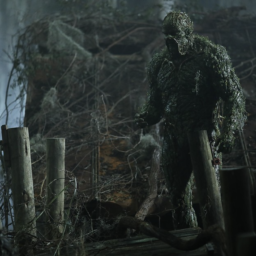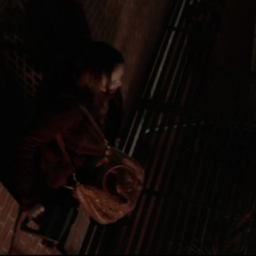The first season of Swamp Thing has already concluded its run on DC Universe, where episodes of the Derek Mears and Crystal Reed-starring series can still be seen and enjoyed for years to come. The series presented new challenges and techniques for CoSA VFX to take on, and those final two episodes contained moments that illustrated more of the strange world that was being built.
CoSA’s VFX Supervisor Tom Mahoney looks back on some of those moments below in an exclusive interview.
Can you talk about how the Blue Devil reveal was put together?
In some of the earlier episodes, there were moments when Dan Cassidy (Ian Ziering) has moments where his arm just catches on fire, with blue flame. And there’s minor burning, but it’s not bad. So when we got into him starting to go into full blue demon mode, we wanted to come up with something that was a little bit more interesting.
When he first starts to go all Blue Devil [earlier], it doesn’t get to the full transformation.
We wanted to create this “blue heat” under the surface, under his skin. That was kind of the feel we were going for. And so when it came to his transformation, we went off of that look even more, where we had this like blue energy “heat” that, with feedback from Mark Verheiden, we made it feel like the blue energy was going to burst out of him.

There’s an intricate sequence in which Swamp Thing’s liver and stomach regenerate on the operating table. Can you talk about that, and were there any visual references that went into it?
They had a kind of organ layout already, that was there practically, so we had to match back into it, but what we ended up doing is cleaning out all the organs.
In Episode 2, we had moments when Swamp Thing was starting to tear himself apart, and then he would re-heal, and we use that for a lot of our guidance for it. We had these smaller vines that would come out and start to form the skeleton of the organs, and then it would smooth over to actually create the organs of the interior.
Since we had that layout that the practical effects guys had already done, we just kind of matched into that and came up with an animation that made it seem like there were regenerating.
Is it more challenging to do stuff with things that organic versus things that are like metal?
I think, absolutely, because organic things have to behave organically.
There’s obviously more of a challenge whenever you’re dealing with something that has to feel that it’s biological in nature. That’s why animating creatures is more difficult than animating cars and helicopters. There’s always much more of a challenge involved in trying to get it to feel just right.
Now, you do buy a little bit of forgiveness in the fact that Swamp Thing is not a real creature. He is obviously an amalgam, but he still is composed of real materials, so you still have to make it feel like it’s it’s not like nanobots assembling Iron Man’s suit, that you can forgive feeling mechanical. You need this to feel more like it’s if there are actual shrubs, and grass, and trees, and things like that actually forming into what is supposed to be Swamp Thing.
What challenges did you have throughout the season when it came to animating CG plants? Was there anything new that the company learned in the process?
The CG team, specifically Michael Capton, Sebastiano D’Aprile, and and some of our animators like Terri Shellen from our animation team – they came up with some really interesting rigs for how we were going to grow the vines that became such a big part of it.
We had three or four different rigs, depending on what kind of vine it was, and then using dynamics on top of it to add additional small detail was something that somebody hit on early in the process. I think we’ve learned a lot of interesting things, and I think the thing that struck me the most about it was just how collaborative it was. The vines weren’t one department. There were so many things being brought together to make them look right.
Do you think Swamp Thing is a show that people will still watch years from now and be like, “damn, this was good?”
I hope so. I mean, with things changing, with how things are in the DC Universe, with HBO Max being announced now and everything like that, who knows? Maybe Swamp Thing will find its way back to life someday in the future. Hard to say.
Is it true that actual rain caused some challenges with integrating the CG plants with the plate?
Oh, absolutely. One of the final battle scenes between Swamp Thing and the mercenaries, practically they shot it with a bunch of rain, so any of our vines, shrubs, anything that had to be added back in, had to have the feeling of the rain being applied back to it as well. So that was definitely interesting.
The ground got muddy, so if we put something on the ground, we had to be careful about how we placed it because there were puddles, and there was mud. If it was in the air, it still had to feel like it was wet… it wasn’t a huge complicating factor, but definitely added complexity to it.
Can you talk about how Swamp Thing’s armor horns were created?
There was definitely a layout that was done by the practical effects guys. They had laid out kind of an armored version of Swamp Thing, but we had to animate [the horns] coming on so that they matched into the practical, armored version of Swamp Thing. I think we augmented them every once in a while in the shots as well, but we were matching into what was practically designed. Did you guys work closely at all with Fractured FX and their practical suits? At the very beginning, we did a lot. They were great. They did a great job. We got scans from them that helped us out a lot. They gave us a lot to build off of.
What can you say about the experience of doing Swamp Thing now that it has completed?
I thought it was great. It pushed our boundaries a little bit. It certainly made us nervous at the beginning, to see how much we could handle. It was a big show. It was exciting for everyone to work on. You know, you have to do things that challenge yourself and as a company, too, because without it, you’re not growing, and I think Swamp Thing certainly helped us grow.
ABOUT CoSA VFX
Founded in 2009, CoSA VFX has grown from a small boutique into a thriving visual effects studio with offices in Los Angeles, Atlanta, and Vancouver. The CoSA VFX team has received Emmy nominations and wins for their work on TV series including Marvel’s Agents of S.H.I.E.L.D., Almost Human, Revolution, and Gotham, and currently provides visual effects for multiple studios, networks and streaming television services.
FOLLOW CoSA VFX
http://cosavfx.com
http://facebook.com/cosavfx
http://twitter.com/cosavfx
https://www.linkedin.com/company/cosa-vfx/
MEDIA CONTACT
Craig Byrne
Publicist/Social Media Manager
Craig.Byrne-IC@cosavfx.com
















